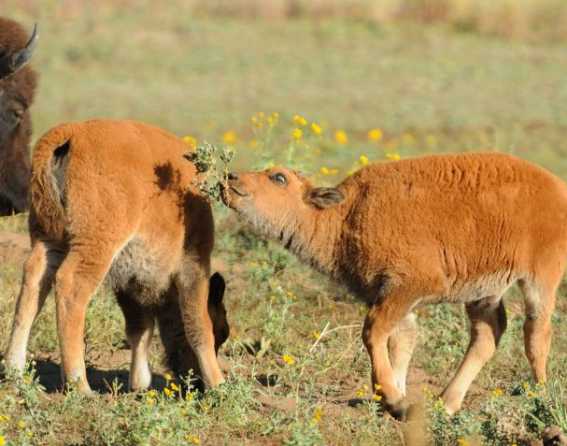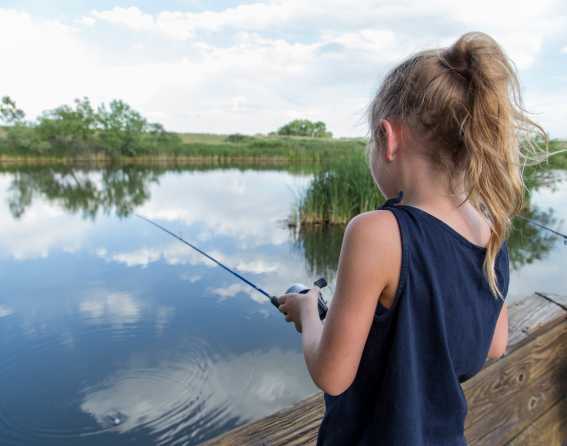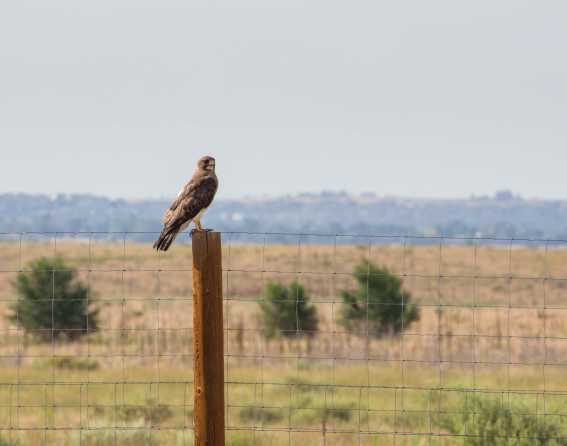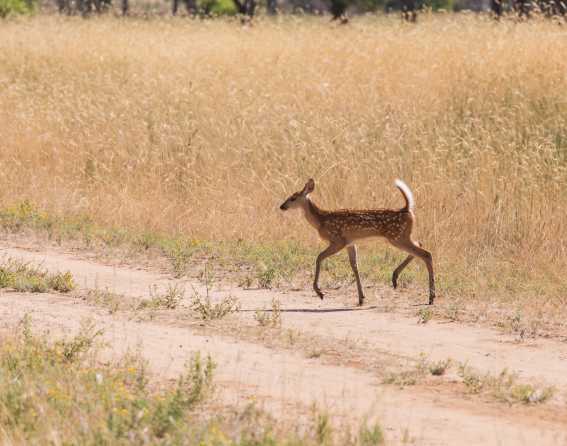Against a vast sea of prairie, the Rocky Mountains rise, unobstructed, on the western horizon. Seemingly miniature and just 10 miles to the southwest, the downtown Denver skyline provides a sense of scale.
On this crisp fall morning, the striking pinks and blonds of the grasses take on a glow along the mostly treeless plains under the blue sky and white clouds. A flock of blackbirds suddenly materializes and dives dramatically towards a mirror-like lake before disappearing just as quickly as it arrived. Waterfowl fish for their breakfast and other birds rustle and chirp in the cattails. The ponds and wetlands are notably alive both above and below the surface of the water.
It’s a reminder of why the Rocky Mountain Arsenal National Wildlife Refuge exists: Of the 330 species of wildlife found in the refuge, about 280 are birds, many of them migrating one direction or the other.
Upwards of 250 bison freely roam in a fenced area that’s slated to expand from 6,500 acres to 10,300 acres in 2024. The population is up from 16 animals that were reintroduced from the National Bison Range in 2007. The refuge’s 11-mile Wildlife Drive allows you to drive into the fenced area (exiting your vehicle is not allowed) to see the herd.
The refuge is also home to recently reintroduced black-footed ferrets, once thought to be extinct. There is an exhibit near the visitor center that’s home to two ferrets from the National Black-Footed Ferret Conservation Center in northern Colorado. They hunt prairie dogs and take over their prey’s labyrinthine burrows after devouring the occupants. There are now about 30 ferrets living in the refuge after the release of 19 in October.
With the suburbs and Dick’s Sporting Goods Park encroaching on the prairie dog burrows at the refuge’s southern boundary near 64th Avenue and Quebec Street, one wonders how this 15,000-acre parkland is so close to a major city.
Settling on Native American hunting grounds, homesteaders saw a similar landscape when they arrived in the late 1800s, then altered it as they started farming the land. Then the U.S. Army ousted 270 homesteads to build a munitions factory for the war effort in 1942.
For the rest of the 20th century, the Rocky Mountain Arsenal was off-limits. It served as the site of manufacturing for a wide range of weapons, chemicals, and chemical weapons, with most of the world’s nerve gas originating here during the early years of the Cold War, not to mention the wholesale disposal of a witch’s brew of chemicals in an underground reservoir once thought to be causing earthquakes in Denver.
Manufacturing gave way to cleanup and restoration in the 1980s. The 1986 return of bald eagles paved the way for the designation of refuge status six years later. It remains home to a few breeding pairs that nest here year-round, often along with migrating eagles that venture south in winter. (It’s fitting that this is the site of the National Eagle Repository, which handles dead eagles and distributes their feathers to Native Americans and Alaska Natives.)
The refuge, which opened to visitors in 2004, is one of the highest-profile remediation sites in the country. It’s hard to overstate just how big of an environmental success story the refuge represents, with the cleanup and restoration, the return of native wildlife, and the subsequent public access to what is now one of the largest urban wildlife refuges nationwide.
Sarah Metzer, the refuge’s public affairs specialist, says the goal is to return the refuge to its pre-settlement state.
“Our goal isn’t actually to just eradicate Army times, it’s to get it all the way back to what it would look like as a natural shortgrass prairie,” says Metzer. “Because of the way [homesteaders] planted the trees for windbreaks, the places that they diverted water for irrigation and whatnot, there’s still quite a bit of restoration work that goes on that has to account for those disturbances to the land.”
The bison’s impact has been pronounced, she adds. Weighing up to 2,000 pounds, the bison graze on native plants, but they grow back stronger, and their mere hoof steps till the soil and fuel more diversity.
“The benefit for us in conserving a species that we nearly eradicated from the North American landscape is that they can do some of the things that we would only be able to accomplish with heavy machinery,” says Metzer. “You’d have to have staff members on big hydraulic machinery digging through soil, drilling seeds into the ground, and they’re doing all of that naturally just by existing out on the prairie.”
Not only is it close to Denver, but the refuge is free to visit. There are now more than 20 miles of trails, several of which are bicycle- and e-bike-friendly, and several lakes and ponds that are open for catch-and-release fishing ($3 fee required). The newly paved Lake Mary Loop is wheelchair-accessible, as are the boardwalks and fishing piers.
In a place surrounded by activity, the human isolation is another striking feature. You can exit I-70 and be on a trail with absolutely no one else in view in a few minutes, the quiet interrupted only by planes taking off from Denver International Airport.
“I find a lot of joy in just being able to go for a walk around the lakes, and I think that’s probably one of my go-to spots for quieter moments,” says Metzer, noting that the lakes, while manmade, have supplanted some of the habitat consumed by development in metro Denver. “We’ve created this little pocket of wetlands that is really rich with a number of different species.”







